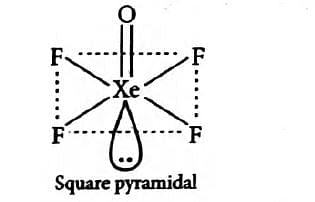What is the hybridization and geometry of the compound $ XeOF_4 $ ?
- $ sp^3\,d^2 $ and octahedral
- $ sp^3\,d $ and square pyramidal
- $ sp^3\,d $ and trigonal bipyramidal
- $ sp^3\,d^2 $ and square pyramidal
The Correct Option is D
Approach Solution - 1
$=\frac{1}{2}(V.E. +M.A. -c+a)$
For, $XeOF_{4}$
$V.E. =8; M.A.$ (monovalent atoms) $= 4$
$(X)=\frac{1}{2}(8+4)\Rightarrow 6$
i.e., $sp^{3} d^{2}$ hybridisation

Approach Solution -2
The compound XeOF4, has 5 sigma bonds, 1 pi bond and 1 lone pair.
The sum of sigma and lone pair is 5 + 1= 6.
It means that there is one s orbital, 3 p orbitals and 2 d orbitals.
Therefore, the hybridization is sp3 d2.
Top Questions on Chemical bonding and molecular structure
What is the empirical formula of a compound containing 40% sulfur and 60% oxygen by mass?
- MHT CET - 2025
- Chemistry
- Chemical bonding and molecular structure
Match the LIST-I with LIST-II.

Choose the correct answer from the options given below :- JEE Main - 2025
- Chemistry
- Chemical bonding and molecular structure
Which of the following molecules(s) show/s paramagnetic behavior?
$\mathrm{O}_{2}$
$\mathrm{N}_{2}$
$\mathrm{F}_{2}$
$\mathrm{S}_{2}$- JEE Main - 2025
- Chemistry
- Chemical bonding and molecular structure
- A group 15 element forms \( d\pi - d\pi \) bond with transition metals. It also forms a hydride, which is the strongest base among the hydrides of other group members that form \( d\pi - d\pi \) bonds. The atomic number of the element is ________________________.
- JEE Main - 2025
- Chemistry
- Chemical bonding and molecular structure
Given below are two statements:
Statement I : The N-N single bond is weaker and longer than that of P-P single bond
Statement II : Compounds of group 15 elements in +3 oxidation states readily undergo disproportionation reactions.
In the light of above statements, choose the correct answer from the options given below- JEE Main - 2025
- Chemistry
- Chemical bonding and molecular structure
Questions Asked in JKCET exam
- 5 books in Math and 3 books in Physics are placed on a shelf so that the books on the same subject always remain together. The possible arrangements are
- JKCET - 2024
- Permutations
- If the length of a chord of a circle is equal to that of radius of the circle, then the angle subtended in radius, at the centre of the circle by the chord is
- Which of the following is a null set?
- Which of the following statement is true?
- Trans-esterification is a reaction between
- JKCET - 2024
- Organic Chemistry - Some Basic Principles and Techniques
Concepts Used:
Chemical Bonding and Molecular Structure
Such a group of atoms is called a molecule. Obviously, there must be some force that holds these constituent atoms together in the molecules. The attractive force which holds various constituents (atoms, ions, etc.) together in different chemical species is called a chemical bond.
Types of Chemical Bonds:
There are 4 types of chemical bonds which are formed by atoms or molecules to yield compounds.
- Ionic Bonds - Ionic bonding is a type of chemical bonding which involves a transfer of electrons from one atom or molecule to another.
- Covalent Bonds - Compounds that contain carbon commonly exhibit this type of chemical bonding.
- Hydrogen Bonds - It is a type of polar covalent bonding between oxygen and hydrogen wherein the hydrogen develops a partial positive charge
- Polar Bonds - In Polar Covalent chemical bonding, electrons are shared unequally since the more electronegative atom pulls the electron pair closer to itself and away from the less electronegative atom.
Factors Affecting Bond Enthalpy in Chemical Bonding:
- Size of the Atom
- Multiplicity of Bonds
- Number of Lone Pair of Electrons Present
- Bond Angle